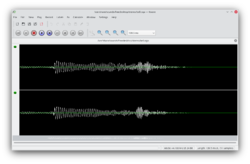Kwave: Difference between revisions
(formatting tweek) |
m (added BreadCrumbs) |
||
| Line 2: | Line 2: | ||
<translate> | <translate> | ||
{{MultiBreadCrumbs|1=Kwave}} | |||
<!--T:1--> | <!--T:1--> | ||
{|class="tablecenter vertical-centered" | {|class="tablecenter vertical-centered" | ||
Revision as of 18:16, 18 August 2020
Home » Applications » Multimedia » Kwave
 |
Sound editor. |
Features
Main Features
- Running on a large variety of platforms
- Precompiled packages available for many distributions
- Available for KDE 4
- GUI can be used in SDI, MDI or Tab mode
- 24 Bit Audio Support
- Undo/Redo
- Use of multicore CPUs (SMP, hyperthreading)
- Simple Drag & Drop
- Realtime Pre-Listen for some effects
- Support for multi-track files
- Playback and recording via native ALSA, PulseAudio (or OSS, deprecated)
- Playback via Phonon
- Load and edit-capability for large files (can use virtual memory)
- Reading and auto-repair of damaged wav-files
- Supports multiple windows
- Extendable Plugin interface
- A nice splashscreen
- Some label handling
Supported File Formats
- WAV Audio (*.wav)
- Ogg/Opus codec (*.opus)
- Ogg/Vorbis audio (*.ogg)
- MP3-Audio (*.mpga *.mp3) and MPEG Layer1 Audio (*.mpga *.mpg *.mp1) (import through libmad and id3lib, export through external encoders like lame)
- FLAC Audio (*.flac)
- All file types supported by libaudiofile:
- AIFF,Amiga,Mac-Audio (*.aifc *.aiff *.aif)
- ULAW (Sun)-Audio (*.au *.snd)
- Berkeley,IRCAM,Carl Sound Format (*.sf)
- ASCII coded Audio (*.ascii)
Plugins
- Amplify free
- Fadein and out
- Go to position
- Insert at position
- Lowpass Filter
- Noise
- Normalize
- Notch Filter
- Pitch Shift
- Playback
- Recording
- Reverse
- Silence
- Samplerate
- Sonagram
- Select Range
- Save Blocks
- Volume
- Zero
- (some more will be follow in future)
Hints, Tips and Troubleshooting
Visit the home page for more details.
